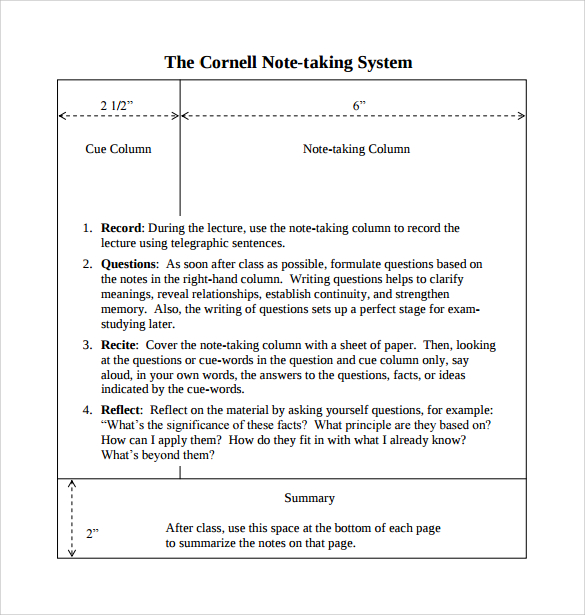

Keep them lined up with your cues, and start a new line for each new note or point

Notes: the large right-hand column is where your notes go.These “cues” help you to organize your notes and pinpoint where relevant notes and answers can be found Cues: the left-hand margin column is for keywords, phrases, subtopics and questions.

Cornell note taking plus#
Title: the top of the page should contain the course and/or topic title, plus the date of your notes.Let’s review what each section should contain: It’s a simple but effective system, and although it looks a little confusing to start with, trust me: it’s worth the effort! The Cornell layoutĬornell notes divide your page and your note-taking into four distinct sections: title, cues, notes, and summary. Indeed, the Cornell method is frequently recommended by high schools and universities, as research has found that teaching the method can improve student achievement. It’s a note-taking strategy that has stood the test of time, remaining popular today. The Cornell notes system was originally devised by Professor Walter Pauk of Cornell University in the 1950s – hence the name! So if you fancy trying some alternative note-taking methods too, great news: we’ve reviewed the top 6 strategies just for you! What is the Cornell note-taking method? Whilst some note-taking methods are more popular than others, what’s most important is that you find one that works for you (and is well suited to your subject, job or business!). Cornell notes resources: our recommendations!.What type of notes does the Cornell method work best for?.What are the benefits of using the Cornell notes system?.What is the Cornell note-taking method?.The resource can be found in the reference section of this website under Alier & Garland. Below is a sample of key points taken from a section from the Solar system chapter called "The Inner Planets".Then students can use the method on their own to help study effectively. Check student understanding of the summarizing technique and reteach if necessary. Finally, have students complete a third section independently.After students finish, go over the notes together and decide on the main points for each section and determine the best summary that focuses on the objectives. The teacher will monitor progress by walking around the room guiding and answering questions. For the next section have students work with partners to fill in the Cornell notes sheet (or have them make their own in their notes) together.This will serve as a good review and help students learn the new skill.
Cornell note taking how to#


 0 kommentar(er)
0 kommentar(er)
